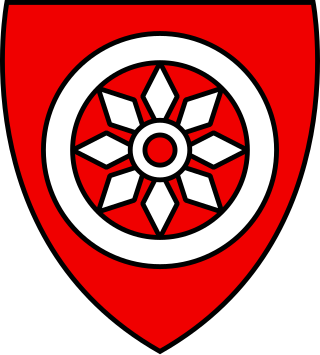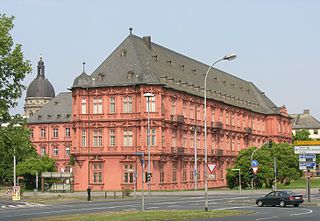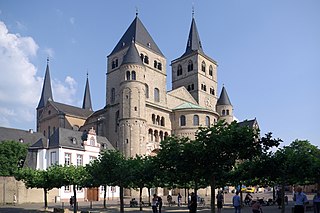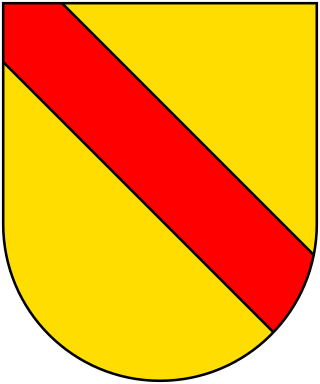

The elector of Trier was one of the prince-electors of the Holy Roman Empire and, in his capacity as archbishop, administered the archdiocese of Trier. The territories of the electorate and the archdiocese were not, however, equivalent.


The elector of Trier was one of the prince-electors of the Holy Roman Empire and, in his capacity as archbishop, administered the archdiocese of Trier. The territories of the electorate and the archdiocese were not, however, equivalent.
The transient authority of archbishops was not gained without opposition. The German kings Otto IV and Conrad IV in 1308 granted charters to the city of Trier, authorizing the jurisdiction of its archbishop, Baldwin of Luxembourg. This prince, brother of Emperor Henry VII, who ruled from 1307 to 1354, was the real founder of the power of Trier. Although his predecessor, Diether III of Nassau, had left the electorate heavily encumbered with debt, Baldwin raised it to great prosperity with the help of the emperors Henry VII, Louis the Bavarian and Charles IV, to whom he had rendered active political and military support. He enlarged his territory almost to its ultimate extent. He assumed the title of arch-chancellor of Gaul and Aries (or Burgundy). In 1315 he accepted the claim of the archbishop of Cologne to hold the highest rank among the spiritual princes of the Empire after the archbishop of Mainz, with the elector of Trier holding third place in the electoral college. After Baldwin's death the prosperity of Trier was reduced by wars and disputes between rival claimants.
In 1456, the estates united for the purpose of restoring order and secured the right to elect their archbishop. Throughout the Middle Ages, the Sancta Civitas Trevirorum [Latin, “Holy City of Trier”] was a flourishing site of religious foundations and became a great center of monastic learning. In the latter half of the 16th century the supervision of the electorate's educational system was taken over by the Jesuits. The university, founded in 1473, continued in operation until 1797.
Archbishop-Elector Richard von Greiffenklau (1467–1531) successfully opposed the Reformation. One of his acts was the exhibition to the public of the Seamless Robe of Jesus, which is believed to have been worn by Jesus before his crucifixion. Trier thereafter became one of the major destinations of Christian pilgrims.

During the Thirty Years' War, Archbishop-Elector Philip Christopher von Sotern favored France and accepted its protection in 1631. The following year, the French army drove all the Spanish and Swedish troops from the electorate, but in March 1635 the Spaniards returned, recaptured Trier and took the archbishop-elector prisoner. He remained in captivity for ten years, but in 1645 was reinstated by the French and confirmed in his authority by the Treaty of Westphalia. The French occupied Trier in 1674 and 1688, but each time their occupation was brief.
The last archbishop-elector, Clement Wenceslaus (1768-1802), granted toleration to the Protestants in 1782. He established his seat of power at Coblenz in 1786, but in 1794 he was forced to flee Napoleon and his Grand Army. Under the Peace of Luneville in 1801 France annexed all the territories of the Electorate of Trier to the west of the Rhine and, in 1802, the archbishop-elector abdicated. A new diocese was created for the French department of the Sarre with Trier as its seat. The electorate’s territories on the east side of the Rhine were secularized and given to Nassau-Weilburg in 1803. In 1814, at the end of the Napoleonic Wars, almost all the former lands of the electorate were allotted to Prussia together with the archdiocese. Another was founded in 1821 with virtually the same boundaries, but it was put under the control of the archbishop of Cologne.


Adolf was the count of Nassau from about 1276 and the elected king of Germany from 1292 until his deposition by the prince-electors in 1298. He was never crowned by the pope, which would have secured him the imperial title. He was the first physically and mentally healthy ruler of the Holy Roman Empire ever to be deposed without a papal excommunication. Adolf died shortly afterwards in the Battle of Göllheim fighting against his successor Albert of Habsburg.

The County of Isenburg was a region of Germany located in southern present-day Hesse, located in territories north and south of Frankfurt. The states of Isenburg emerged from the Niederlahngau, which partitioned in 1137 into Isenburg-Isenburg and Isenburg-Limburg-Covern. These countships were partitioned between themselves many times over the next 700 years.

The Electorate of Trier was an ecclesiastical principality of the Holy Roman Empire that existed from the end of the 9th to the early 19th century. It was the temporal possession of the prince-archbishop of Trier who was, ex officio, a prince-elector of the empire. The other ecclesiastical electors were the electors of Cologne and Mainz.

The Elector of Mainz was one of the seven Prince-electors of the Holy Roman Empire. As both the Archbishop of Mainz and the ruling prince of the Electorate of Mainz, the Elector of Mainz held a powerful position during the Middle Ages. The Archbishop-Elector was president of the electoral college, archchancellor of the empire, and the Primate of Germany as the papal legate north of the Alps, until the dissolution of the empire in 1806.

Diether von Isenburg was twice Archbishop and founder of the University of Mainz. As Archbishop of Mainz, he was ex officio Elector and Lord Chancellor of Germany.

The Electoral Palace in Mainz is the former city Residenz of the Prince-elector and Archbishop of Mainz. It is one of the important Renaissance buildings in Germany.
Bohemond II of Saarbrücken, also known as Boëmund II von Ettendorf-Warnesberg, was a German theologian who served as Archbishop and Elector of Trier from 6 February 1354 until his resignation in 1362.

Prince Clemens Wenceslaus of Saxony was a Saxon prince from the House of Wettin and the Archbishop-Elector of Trier from 1768 until 1803, the Prince-Bishop of Freising from 1763 until 1768, the Prince-Bishop of Regensburg from 1763 until 1769, and the Prince-Bishop of Augsburg from 1768 until 1803.
Isenburg-Grenzau was the name of several states of the Holy Roman Empire, seated in the Lordship of Grenzau, in modern Rhineland-Palatinate, Germany. The first state called Isenburg-Grenzau existed 1158–1290; the second 1341–1439; and the third 1502–1664.

The Diocese of Trier, in English historically also known as Treves from French Trèves, is a Latin Church ecclesiastical territory or diocese of the Catholic church in Germany. When it was the archbishopric and Electorate of Trier, it was one of the most important states of the Holy Roman Empire, both as an ecclesiastical principality and as a diocese of the church. Unlike the other Rhenish dioceses—including Mainz and Cologne–Trier was the former Roman provincial capital of Augusta Treverorum. Given its status, Trier has continuously been an episcopal see since Roman times and is one of the oldest dioceses in all of Germany. The diocese was elevated to an archdiocese in the time of Charlemagne and was the metropolitan for the dioceses of Metz, Toul, and Verdun. After the victory of Napoleon Bonaparte of France, the archdiocese was lowered to a diocese and is now a suffragan in the ecclesiastical province of the Archdiocese of Cologne. The diocesan cathedral is the Cathedral of Saint Peter. The Cathedral Chapter retains the right to elect the bishop, rather than selection by papal appointment.
The Congress of Ems was a meeting set up by the four prince-archbishops of the Holy Roman Empire, and held in August 1786 at Bad Ems in the Electorate of Trier. Its object was to protest against papal interference in the exercise of episcopal powers, and to fix the future relations between the participating archbishops and the pope. Representatives of the three elector-archbishops: Friedrich Karl von Erthal of Mainz, Maximilian Franz of Cologne, Clemens Wenceslaus of Trier, as well as of Prince-Archbishop Hieronymus von Colloredo of Salzburg took part.

Philipp Christoph von Sötern was the Prince-Bishop of Speyer from 1610 to 1652 and the Archbishop-Elector of Trier from 1623 to 1652.

John II of Baden was a titular Margrave of Baden and was Archbishop and Elector of Trier as John II of Baden from 1456 until his death in 1503.
The Mainz Diocesan Feud, also known as the Baden-Palatine War, took place in 1461/1462 and was a warlike conflict for the throne of the Electorate of Mainz.

The ruins of Ramstein Castle stand on a 182-metre-high, Bunter sandstone rock on the edge of the Meulenwald forest in the lower, steep-sided Kyll valley near Kordel in the German state of Rhineland-Palatinate. It stands 9 kilometres (5.6 mi) north of Trier and the same east of Luxembourg.
Diether of Nassau, German: Diether von Nassau was a clergyman from the Walramian branch of the House of Nassau. From 1300 to 1307 he was Archbishop and Elector of Trier as Diether III.

Adolf I von Nassau was Bishop of Speyer 1371–1388 and Archbishop of Mainz 1381–1390.

Frederick von Saarwerden was archbishop-elector of Cologne as Frederick III from 1370 to 1414. Through the promotion of his great-uncle, Archbishop Kuno II of Falkenstein of Trier, Frederick von Saarwerden was elected archbishop of Cologne at the age of 20, which the Pope in Avignon also confirmed two years later after some misgivings. Frederick found the archbishopric completely plundered by his two predecessors of the County of Mark, Adolf and Engelbert, and had himself promised high payments to the Curia on the occasion of his election. Nevertheless, with the help of his very rich great-uncle Kuno, he succeeded in paying off the debts of the archbishopric within a few years.
This article incorporates text from a publication now in the public domain : Gough, Alfred Bradley (1911). "Trier". In Chisholm, Hugh (ed.). Encyclopædia Britannica . Vol. 27 (11th ed.). Cambridge University Press. pp. 268–269.